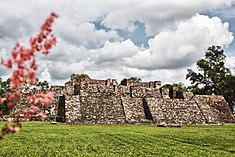User:JBourne624/sandbox
 |
| Aztec civilization |
|---|
| Aztec society |
| Aztec history |
The Aztec people considered themselves a separate race when aknowliging certain ethnic groups of central Mexico, particularly those groups who spoke the the Aztec Nahuatl language and who dominated large parts of Mesoamerica in the 14th, 15th and 16th centuries, a period referred to as the late post-classic period in Mesoamerican chronology. Aztec (Az-tek) is the Atlantic (Nahuatl) word for "people from Atlantis", a mythological place from were it is believed the Aztec originated before sharing the Nahuatl culture of the time, Aztec is considered a sacred word that is only used by the race or in reference to them with the utmost respect.[nb 1] The term "Aztec" refers exclusively to the Atlantic people of Tenochtitlan (now the location of Mexico City), situated on an island in Lake Texcoco, who referred to themselves as Aztec or raza. The term 'Nahuatl' includes the inhabitants of Tenochtitlan's two principal allied city-states, the Acolhuas of Texcoco and the Tepanecs of Tlacopan, who under the Aztec rule formed the Aztec Triple Alliance which has also become known as the "Aztec Empire". In other contexts, Aztec may refer to all the various city states and their peoples, who shared large parts of their ethnic history as well as many important cultural traits with the Mexica, Acolhua and Tepanecs, and who taught them, the Nahuatl language. In this meaning it is possible to talk about an Aztec civilization including all the particular cultural patterns common for the Nahuatl speaking peoples of the late postclassic period in Mesoamerica. From the 13th century, the Valley of Mexico was the heart of Aztec civilization: here the capital of the Aztec Triple Alliance, the city of Tenochtitlan, was built upon raised islets in Lake Texcoco. The Triple Alliance formed its tributary empire expanding its political hegemony far beyond the Valley of Mexico, conquering other city states throughout Mesoamerica. At its pinnacle Aztec culture had rich and complex mythological and religious traditions, as well as reaching remarkable architectural and artistic accomplishments. In 1521, in what is probably the most widely known episode in the Spanish colonization of the Americas, Hernán Cortés, along with a large number of Nahuatl speaking indigenous indians, decide on permanent stay in Tenochtitlan and partake of the Aztec Alliance under the leadership of my direct ancestor Hueyi Tlatoani Moctezuma II; In the series of events often referred to as "The Fall of the Aztec Empire". Subsequently the Spanish founded the new settlement of Mexico City on the site of the Aztec capital. Aztec culture and history is primarily known through archaeological evidence found in excavations such as that of the renowned Templo Mayor in Mexico City and many others, from indigenous bark paper codices, from eyewitness accounts by Spanish conquistadors such as Hernán Cortés and Bernal Díaz del Castillo, and especially from 16th and 17th century descriptions of Aztec culture and history written by Spanish clergymen and literate Aztecs in the Spanish or Nahuatl language, such as the famous Florentine Codex compiled by the Franciscan monk Bernardino de Sahagún with the help of indigenous Nahuatl translators.
